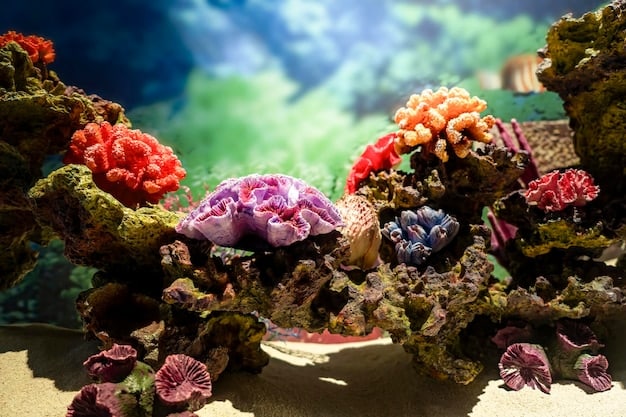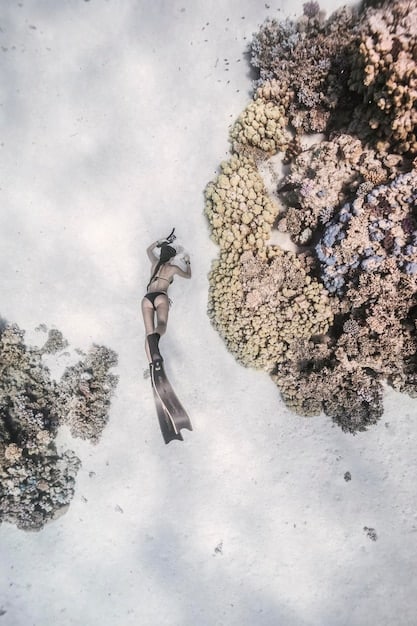Coral Reef Restoration: Tech Solutions for Climate Change

Climate change significantly impacts coastal ecosystems, particularly coral reefs, necessitating innovative technological solutions for their restoration and resilience against rising temperatures and ocean acidification.
The intricate underwater worlds of coral reefs are facing an unprecedented crisis. As global temperatures rise and oceans warm, the very foundation of these vibrant ecosystems, the corals themselves, are under immense threat. Understanding the impact of climate change on coastal ecosystems: what technologies can help restore coral reefs? is not just an academic exercise; it’s a critical quest for survival, for both marine life and the human communities that depend on these natural wonders.
The escalating crisis: climate change’s grip on coral reefs
Coral reefs, often called the “rainforests of the sea,” sustain approximately 25% of all marine life, provide coastal protection, and support vast economies through tourism and fisheries. However, these vital ecosystems are exquisitely sensitive to changes in their environment, making them particularly vulnerable to the ongoing effects of climate change. The twin threats of ocean warming and acidification are leading to widespread coral bleaching and degradation on a scale never before witnessed.
Ocean warming, driven by increased greenhouse gas emissions, causes corals to expel their symbiotic algae, zooxanthellae, which provide them with essential nutrients and their vibrant colors. This process, known as coral bleaching, leaves the coral white and vulnerable to disease and death if temperatures do not quickly return to normal. Repeated and prolonged bleaching events are pushing many reefs beyond their capacity to recover naturally.
Beyond bleaching, ocean acidification, a direct consequence of increased carbon dioxide absorption by seawater, further exacerbates the problem. As CO2 dissolves, it forms carbonic acid, reducing the availability of carbonate ions—the building blocks corals and other calcifying organisms need to construct their skeletons and shells. This makes it harder for corals to grow and repair themselves, weakening their structures and making them more susceptible to erosion and physical damage.
The dual threats of warming and acidification
These two phenomena, ocean warming and acidification, don’t act in isolation; they are synergistic, creating a devastating one-two punch for coral reefs. Warmer waters stress the corals, making them more prone to bleaching, while increased acidity weakens their very skeletons. This combination hinders their natural growth and ability to recover from other stressors, such as pollution and overfishing.
- Marine heatwaves: Increasingly frequent and intense marine heatwaves are pushing corals past their thermal thresholds, leading to mass bleaching events globally.
- Reduced calcification: Lower pH levels in the ocean directly impede the ability of corals to form and maintain their calcium carbonate skeletons.
- Loss of biodiversity: As corals decline, so does the vast array of species that rely on them for food, shelter, and breeding grounds, leading to cascading effects throughout marine ecosystems.
The long-term consequences of these changes extend far beyond the reefs themselves. Coastal communities face increased vulnerability to storms and erosion as the natural breakwaters provided by reefs diminish. Fisheries collapse as fish populations dwindle, impacting food security and livelihoods. The urgency of developing effective restoration technologies has never been greater, as natural recovery alone is no longer sufficient to counteract the scale of destruction.

Traditional coral propagation methods: a foundation for innovation
For decades, conservationists and marine biologists have been working on methods to restore damaged coral reefs. These traditional approaches, primarily focusing on coral propagation and outplanting, form the bedrock upon which newer, more advanced technologies are being built. Understanding these established techniques is crucial to appreciating the innovations that are now emerging.
One of the most common traditional methods involves “coral gardening,” where fragments of healthy coral are collected from donor colonies, raised in underwater nurseries, and then outplanted back onto degraded reefs. These nurseries can range from simple ropes and frames to more complex structures designed to maximize growth rates. The fragments are carefully monitored and maintained until they reach a size suitable for transplantation.
Another approach is the direct transplantation of entire coral colonies from one area to another. This is often done when infrastructure projects or other developments threaten existing reefs, offering a way to salvage and relocate corals to safer environments. While labor-intensive and challenging, it has proven effective for specific localized situations, providing immediate, albeit limited, benefit.
Nurseries and outplanting: the hands-on approach
Coral nurseries serve as essential intermediate steps in the restoration process. They allow for the rapid growth of coral fragments in a controlled environment, protecting them from some of the immediate stressors present on a degraded reef. Once the fragments are large enough, they are then painstakingly attached to the reef substrate using various methods, from cement to zip ties. The choice of coral species for propagation is also critical, with an emphasis on fast-growing and resilient types.
- Fragment collection: Sourcing healthy coral fragments from donor colonies with minimal stress to the parent colony.
- Nursery care: Maintaining optimal conditions in underwater nurseries, including cleaning and protecting fragments from predators.
- Outplanting techniques: Securely attaching grown coral fragments to the reef using environmentally safe methods to ensure long-term survivability.
These traditional methods, while effective on a localized scale, face significant limitations when confronted with the immense scale of degradation caused by climate change. They are labor-intensive, time-consuming, and often struggle to keep pace with the rate of reef decline. Moreover, outplanted corals remain susceptible to the same environmental stressors that caused the original damage. This inherent vulnerability underscores the necessity for technological advancements that can enhance resilience, accelerate growth, and operate at a much larger scale.
Cutting-edge technologies for enhanced coral restoration
The urgency of the coral reef crisis has spurred a wave of innovation, leading to the development of cutting-edge technologies that aim to overcome the limitations of traditional restoration methods. These advancements range from genetic manipulation and assisted evolution to robotic systems and advanced materials, all working towards building more resilient and rapidly recovering reefs.
One promising area involves genomics and selective breeding. Researchers are identifying and breeding corals that exhibit natural resilience to higher temperatures and ocean acidity. By understanding the genetic basis of heat tolerance, scientists can identify “super corals” and propagate them, or even use gene-editing techniques to enhance traits that promote survival in changing conditions. While still in its early stages and raising ethical considerations, this approach holds significant long-term potential for creating more robust coral populations.
Automation and robotics are also playing an increasingly vital role. Autonomous Underwater Vehicles (AUVs) and Remotely Operated Vehicles (ROVs) equipped with AI capabilities can survey vast reef areas, monitor coral health, and even assist in outplanting activities. These robots can work longer and deeper than human divers, improving the efficiency and scale of restoration efforts. Some prototypes are even designed to 3D-print structures that mimic natural reef formations, providing new substrates for coral attachment.
Synthetic materials and bioremediation for reef recovery
Beyond live coral propagation, advancements in synthetic materials and bioremediation offer alternative avenues for supporting reef ecosystems. Scientists are experimenting with 3D-printed ceramic structures that mimic the complexity of natural reefs, providing stable foundations for coral growth and habitat for reef fish. These structures can be designed to withstand extreme weather events and provide immediate structural integrity to degraded areas.
- Assisted evolution: Techniques like selective breeding and genetic engineering to enhance coral resilience to thermal and acidic stressors.
- Robotics and AI: Utilization of AUVs and ROVs for large-scale reef monitoring, mapping, and potentially automated coral outplanting.
- 3D printing: Creation of artificial reef structures using calcium carbonate or eco-friendly materials, providing new substrates for coral attachment.
Bioremediation, using beneficial microbes to improve water quality or mitigate the effects of pollution, is another emerging field. While not directly restoring corals, it addresses underlying environmental stressors that hinder their recovery. For instance, specific microbial communities could potentially help corals cope with stress or even consume pollutants that negatively impact reef health. These diverse technological approaches highlight a multifaceted strategy, moving beyond simple transplantation towards creating a more sustainable and resilient future for coral reefs.
Monitoring and measuring success: the role of data and AI
Effective coral reef restoration isn’t just about planting new corals; it’s crucially about monitoring their survival, growth, and the overall health of the restored ecosystem. This is where advanced data collection, remote sensing, and artificial intelligence come into play, providing invaluable tools to measure the success of restoration efforts and adapt strategies for better outcomes.
Satellite imagery, aerial drones, and underwater sensors provide a continuous stream of data on reef conditions, including water temperature, pH levels, turbidity, and coral cover. This remote sensing capability allows for the tracking of large areas, identifying early signs of stress or success, and understanding the long-term changes occurring on a reef. Coupled with in-situ measurements taken by divers, these data sources create a comprehensive picture of ecosystem health.
The sheer volume of data generated necessitates the use of artificial intelligence and machine learning. AI algorithms can rapidly analyze images to detect coral bleaching, disease, or growth patterns that would be impossible for human researchers to process manually. Machine learning models can also predict future reef health trends based on environmental parameters, helping restoration managers make proactive decisions about where and how to intervene most effectively. This predictive capability is vital for optimizing restoration resources and achieving meaningful, lasting impact.
From satellite to seabed: comprehensive data collection
The integration of diverse data sources, from the macro scale of satellite observations to the micro details captured by underwater cameras, provides a holistic view of reef ecosystems. This multi-layered approach allows scientists to correlate environmental changes with coral health and identify specific stressors that might be hindering recovery. The ability to track individual outplanted corals through image recognition further refines our understanding of what works and what doesn’t in various conditions.
- Remote sensing: Satellite and drone imagery for broad-scale mapping of coral cover, habitat changes, and bleaching events.
- Underwater sensors: Real-time monitoring of water quality parameters, including temperature, pH, and light levels, directly on the reef.
- AI for image analysis: Machine learning algorithms to automate the identification of coral species, health status, and growth rates from photographic data.
The iterative process of data collection, analysis through AI, and subsequent refinement of restoration techniques is transforming coral conservation from reactive intervention to proactive, science-driven management. By rigorously measuring success, not just by the number of corals planted but by their long-term survival and contribution to ecosystem function, technology helps ensure that restoration efforts are truly impactful and sustainable in the face of ongoing climate challenges.
Policy and international collaboration: vital for scaling solutions
While technological advancements offer powerful tools for coral reef restoration, their effectiveness is greatly amplified and sustained through supportive policy frameworks and robust international collaboration. No single nation or organization can solve the global coral crisis alone; it requires a concerted effort that transcends geographical and political boundaries.
National and local governments play a crucial role in establishing marine protected areas (MPAs), regulating coastal development, managing fisheries, and controlling pollution—all of which reduce localized stressors on reefs, thereby increasing the chances of success for restoration initiatives. Policies promoting sustainable tourism and responsible waste management also contribute significantly to creating healthier conditions for reefs. Furthermore, governments can incentivize research and development in new restoration technologies, fostering innovation and facilitating the scaling of successful methods.
On the international stage, multilateral agreements and collaborative initiatives are essential for sharing best practices, pooling resources, and coordinating efforts across vast ocean territories. Organizations like the United Nations, through its Sustainable Development Goals, and various international conservation bodies facilitate platforms for countries to work together on common challenges. Sharing scientific data, technological know-how, and funding mechanisms accelerates the global response to the coral crisis.
Funding and knowledge sharing: pillars of progress
Securing adequate funding for research, implementation, and long-term monitoring of restoration projects is a perpetual challenge. Public-private partnerships, philanthropic investments, and climate adaptation funds are all critical sources that enable cutting-edge technologies to move from laboratories to the field. Transparent reporting and demonstrable success are key to attracting sustained investment.
- Marine Protected Areas (MPAs): Policy mechanisms to safeguard critical reef habitats from destructive human activities.
- Cross-border research: Collaborative projects that allow scientists from different countries to combine expertise and resources on shared reef systems.
- Capacity building: Programs that train local communities and scientists in developing countries to implement and manage restoration technologies effectively.
Ultimately, the technological solutions developed today must be integrated into broader conservation strategies and supported by a global commitment to address the root cause of the problem: climate change itself. Without significant reductions in greenhouse gas emissions, even the most advanced restoration technologies will be fighting an uphill battle against ever-increasing ocean temperatures and acidity. Therefore, policy and collaboration are not just supportive elements; they are foundational to the long-term viability of coral reef ecosystems.
Challenges and future outlook for reef restoration technologies
Despite the remarkable progress in developing innovative technologies for coral reef restoration, significant challenges remain. The sheer scale of reef degradation globally, coupled with the relentless pace of climate change, means that even the most advanced solutions are currently playing catch-up. Understanding these hurdles is critical for setting realistic expectations and guiding future research and development.
One major challenge is the cost and scalability of many cutting-edge technologies. Genetic engineering, advanced robotics, and bespoke 3D-printed structures are often expensive and difficult to deploy across vast, remote reef systems. Finding ways to reduce costs and streamline processes, while maintaining efficacy, is crucial for widespread adoption. Furthermore, the specialized skills required to operate and maintain these technologies are not always readily available in regions where reefs are most at risk.
Another hurdle is the inherent unpredictability of the ocean environment. Despite efforts to create more resilient corals, extreme marine heatwaves, powerful storms, and localized pollution events can still wipe out years of restoration work. Developing technologies that can withstand such shocks, or provide rapid recovery mechanisms, remains a key area for ongoing research. The genetic diversity of restored populations also needs careful management to ensure they are robust enough to adapt to future environmental changes without creating unintended ecological consequences.
Ensuring long-term ecological success
The ultimate goal of restoration is not merely to grow corals, but to restore functional ecosystems. This means ensuring that outplanted corals not only survive but thrive, reproduce, and support the diverse marine life that depends on them. Measuring this ecological success over the long term is complex and requires sustained monitoring and adaptive management.
- Cost-effectiveness: Developing affordable and scalable technologies that can be implemented globally, particularly in developing nations.
- Extreme event resilience: Engineering corals or restoration methods that can better withstand thermal stress, acidification, and physical damage from storms.
- Holistic ecosystem recovery: Focusing beyond just coral growth to promote the return of associated biodiversity and full ecological function.
Looking ahead, the future of coral reef restoration technologies is likely to involve an integrated approach, combining the best aspects of traditional methods with advanced scientific and engineering innovations. Continued interdisciplinary research, international partnerships, and sustained funding will be essential. While the challenges are immense, the ingenuity and dedication of scientists and conservationists worldwide offer a glimmer of hope that, with the right technological interventions and a global commitment to climate action, these irreplaceable marine ecosystems can still be preserved for future generations.
| Key Point | Brief Description |
|---|---|
| 🌡️ Climate Impact | Ocean warming and acidification cause coral bleaching and skeletal weakening, leading to widespread reef degradation. |
| 🌱 Traditional Methods | Coral gardening and outplanting are foundational but limited in scale for climate change impacts. |
| 🔬 New Technologies | Genomics, robotics, and 3D printing enhance resilience and accelerate large-scale restoration efforts. |
| 📊 Data & AI | Remote sensing and AI provide crucial monitoring and predictive insights for effective restoration. |
Frequently asked questions about coral reef restoration
▼
Coral bleaching occurs when corals expel the symbiotic algae living in their tissues, typically due to stress from increased water temperatures. These algae provide corals with most of their food and color. Without them, corals turn white and can starve, leading to widespread death if temperatures don’t return to normal.
▼
Ocean acidification is caused by the absorption of excess carbon dioxide by seawater, which lowers its pH. This makes it harder for corals and other calcifying organisms to build and maintain their calcium carbonate skeletons and shells, weakening their structure and growth rates, making them more vulnerable.
▼
Yes, 3D printing is being used to create artificial reef structures that mimic natural formations. These structures provide new, stable substrates for coral fragments to attach and grow, offering immediate habitat for marine life and helping to rebuild the physical complexity of degraded reefs effectively and efficiently.
▼
Robotics, including AUVs and ROVs, enhance restoration by autonomously surveying vast reef areas, monitoring coral health, and assisting in outplanting. These robotic systems can work longer and deeper than human divers, collect much more data, and potentially accelerate the scale and efficiency of restoration activities.
▼
While innovative technologies are powerful tools, they alone cannot save coral reefs. They are crucial for active restoration and building resilience, but must be paired with aggressive global action to reduce greenhouse gas emissions, control pollution, and implement effective marine protection policies to address the root causes of reef decline.

Conclusion
The challenges facing coral reefs due to climate change are immense, yet the rapid advancements in restoration technologies offer a beacon of hope. From understanding the intricate genetic makeup of resilient corals to deploying autonomous robots for large-scale reforestation, the scientific and engineering communities are providing innovative solutions to combat environmental degradation. However, these technological triumphs alone are insufficient. Their true impact hinges on their integration into robust policy frameworks, sustained international collaboration, and a collective global commitment to mitigate the overarching threats of climate change. Only then can we genuinely hope to restore and preserve these vital, breathtaking ecosystems for generations to come, ensuring their role as cornerstones of marine biodiversity and crucial protectors of our coastal regions.





